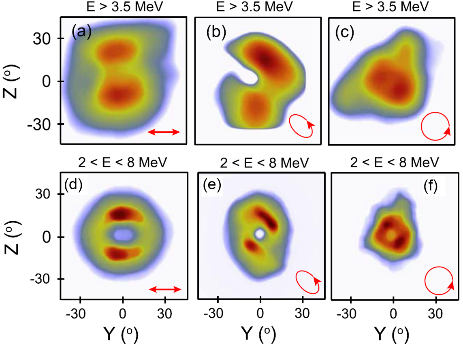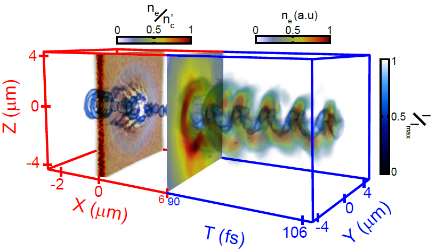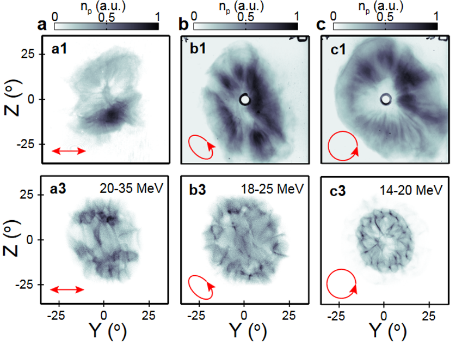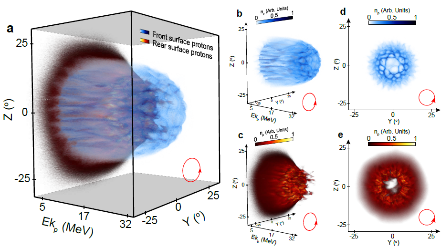Kansai Photon Science Institute >> KPSI Seminar >> Collective charged particle dynamics in relativistically transparent laser-plasma interactions
Seminar
The 31st KPSI Seminar
Collective charged particle dynamics in relativistically transparent laser-plasma interactions
| Presentor | Dr. Bruno Gonzalez izquierdo (High-Intensity Laser Science Group/KPSI) |
|---|---|
| Jobstatus | JSPS Foreign Research Fellow |
| Place | ITBL G201 room(KPSI) |
| Date | 09:30 - (Wed.) Nov 15, 2017 |
| Language | English |
| abstract | [PDFfile/256KB] |
Collective charged particle dynamics in relativistically transparent laser-plasma interactions
Dr. Bruno Gonzalez izquierdo
(High-Intensity Laser Science Group/KPSI)
abstract
Significant progress has been made over the past decade in elucidating the physics of ultraintense laser pulse interactions with solid and gas targets. This has been motivated by fundamental investigations of plasma generation in extreme conditions and the development of compact laser-driven particle and radiation sources [1]. The case of ultrathin (tens-to-hundreds of nanometres) foil targets have received particular attention due to their use in the development of ion acceleration based on the radiation pressure (RPA) of the intense laser light [2]. In spite of foils, which are sufficiently thin enough to expand and undergo relativistic self-induced transparency (RSIT) [3] during the interaction, exhibit a detrimental in ion acceleration, recent studies have demonstrated that new and unsuspected phenomena arise in this regime.
My past research has been focused on experimental and numerical (via 2D-3D PIC simulations) investigations of the collective response of electrons and ions to the interaction of ultra-intense (1020 Wcm-2) laser with ultra-thin (nanometre scale) foils undergoing expansion and RSIT. Investigations of the collective response of electrons [4, 5] and protons [6] show that a “relativistic plasma aperture” is generated by intense laser light in this regime, resulting in diffraction. It was numerically found that the plasma electrons collectively respond to the produced laser near-field diffraction pattern, resulting in a beam of energetic electrons with spatial-intensity distribution, related to this diffraction structure, which can be controlled by variation of the laser pulse parameters (Figure 1). Additionally, it was shown that static electron beam structures can be made to rotate at fixed or variable angular frequencies depending on the degree of ellipticity in the laser polarisation (Figure 2). Besides, the results showed that the electron dynamics is mapped onto the beam of protons accelerated via strong charge-separation-induced electrostatic fields (Figure 3 & Figure 4).

Figure 1.
Experimental electron density for (a) linear, (b) elliptical and (c) circular polarization. (d-f) Same from 3D simulation results.

Figure 2.
Combined plot showing the 3D laser intensity profile and the temporal evolution of the electron density distribution for circular polarization.

Figure 3.
Experimental proton density for (a1) linear, (b1) elliptical and (c1) circular polarization. (a3-c3) Same from 3D simulation results.

Figure 4.
(a) Combined plot showing the 3D proton density from front and rear surface. (b) and (d) Front surface protons (lateral and front view); (c) and (e) Rear surface protons.
[1] H. Daido et al., Rep. Prog. Phys., 75, 056401 (2012)
[2] T. Esirkepov et al., Phys. Rev. Lett., 92, 175003 (2004)
[3] V. I. Eremin et al., Phys. Plasmas, 17, 043102 (2010)
[4] B. Gonzalez-Izquierdo et al., Nature Physics, 12, 505-512 (2016)
[5] B. Gonzalez-Izquierdo et al., HPLSE, 4, e33 (2016)
[6] B. Gonzalez-Izquierdo et al., Nature Comms., 7, 12891 (2016)
[previous page]
The 30th KPSI Seminar Short-pulse high-intensity laser-plasma science using an X-ray free electron laser
[next page]
The 32nd KPSI Seminar Relativistic electron-positron jets from intense lasers
